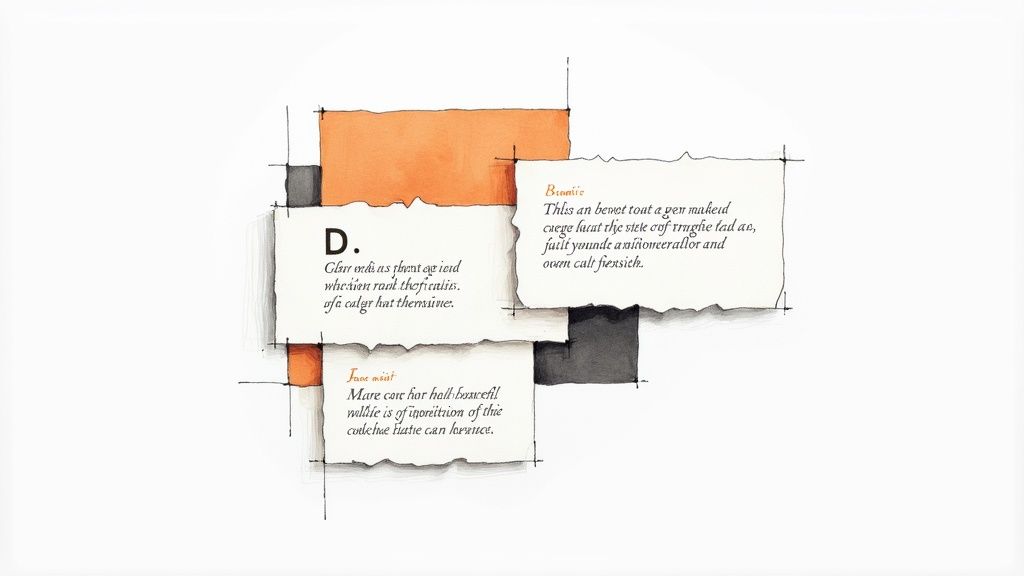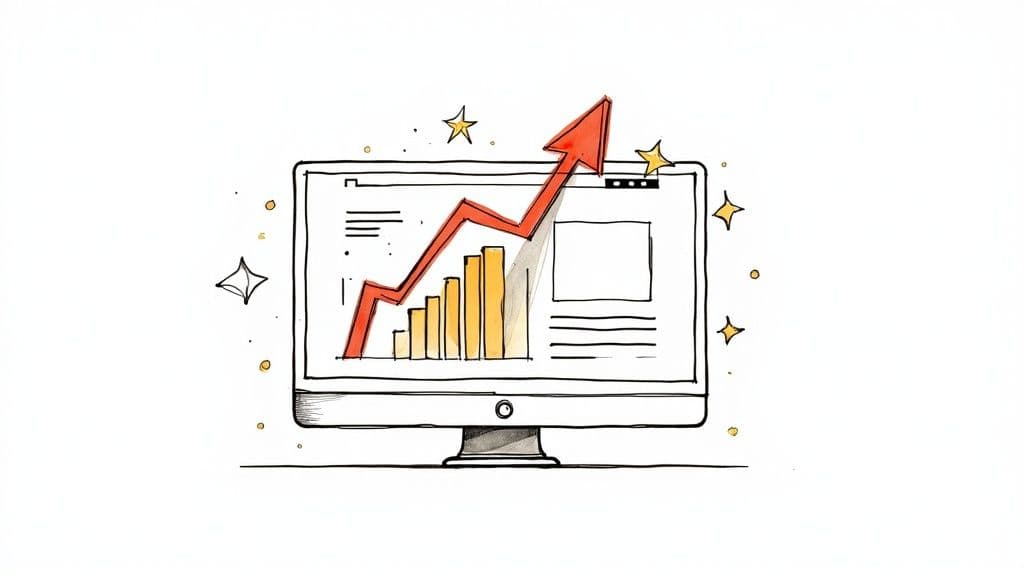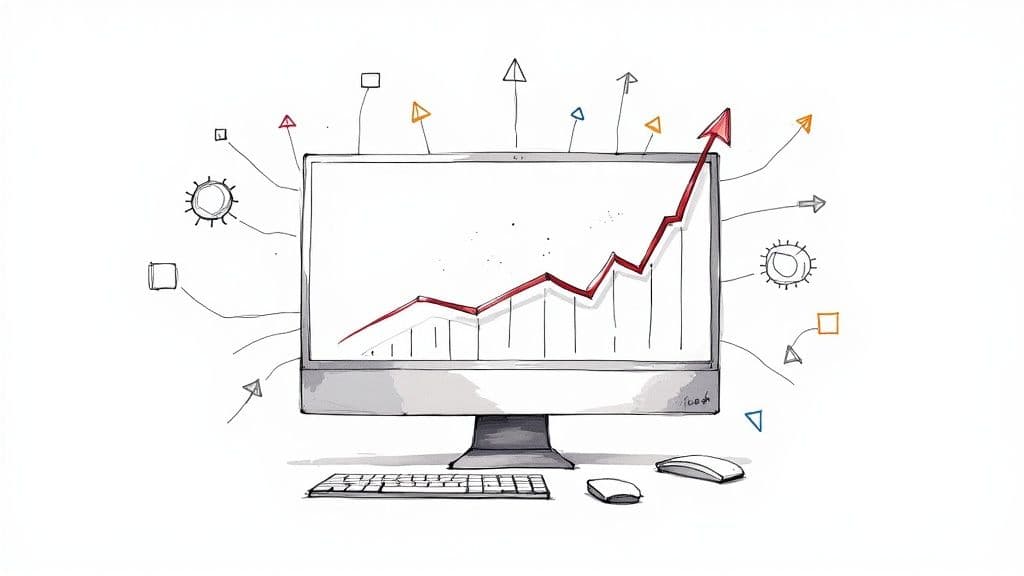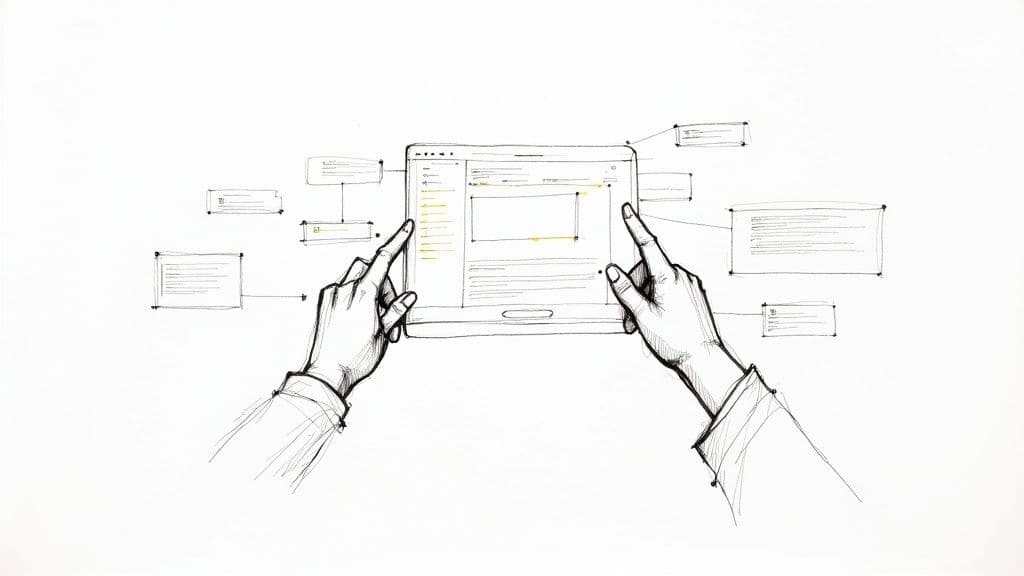The Measurable Impact of Landing Page Copy

Effective landing page copywriting is the cornerstone of successful online marketing. It's the bridge that connects your product or service with potential customers, guiding them towards conversion. Its impact goes beyond simply providing information; it directly influences your bottom line. Investing in high-quality landing page copy is crucial for maximizing your return on investment (ROI). This section explores why compelling copy consistently outperforms other marketing efforts, such as technical tweaks or design changes.
Why Copy Matters More Than You Think
Think of your landing page as a storefront. Your design and website speed are like curb appeal and ease of parking. They’re important, but they won't guarantee sales. It's the persuasive salesperson inside—your landing page copy—that convinces customers to buy.
Compelling copy engages visitors, addresses their needs, and motivates them to take action. This results in increased conversion rates, a key metric for any online business.
The Power of Persuasion: Data-Backed Insights
Persuasive copy isn’t just about flowery language. It’s about understanding your audience and crafting a message that resonates. Landing page copywriting plays a crucial role in maximizing conversions.
One statistic highlights that landing pages with persuasive copy have a 16% higher conversion rate than those without. Landing page copy written at a 5th to 7th-grade reading level tends to have the highest conversion rate at 11.1%. This significantly outperforms more complex content written at a college level, which converts at around 5.3%.
Personalized calls-to-action (CTAs) can further boost performance by an impressive 202%. This emphasizes the importance of clarity, simplicity, and personalization. Find more detailed statistics here: Learn more about copywriting statistics. Focusing on clear, concise messaging tailored to the individual drastically improves the effectiveness of your landing page.
Translating Copy Into Conversions
The impact of strong landing page copy is measurable. Higher conversion rates translate directly into more leads, sales, and ultimately, revenue. A simple change in headline copy, for example, can significantly increase click-through rates.
Well-crafted body copy can effectively address customer objections, leading to a higher percentage of visitors completing the desired action. This might be signing up for a newsletter or making a purchase. This makes landing page copywriting one of the most impactful investments in your marketing arsenal.
From Visitors to Customers: The Copy Connection
By understanding the measurable impact of landing page copy, businesses can make informed decisions about their marketing strategies. Investing in skilled landing page copywriters or learning the principles of effective copywriting can lead to substantial improvements in conversion rates and overall business growth. This sets the stage for exploring the specific elements that make landing page copy truly effective.
Anatomy of High-Converting Landing Page Copy
We've talked about the importance of compelling landing page copy. Now, let's explore the key elements that make a landing page truly effective at converting visitors into customers. Understanding the difference between copywriting and content writing is essential. A good starting point is this article detailing the differences between copywriting and content writing. This will provide a solid foundation for approaching landing page copywriting.
The Headline: Capturing Immediate Attention
The headline is your first, and often only, opportunity to grab a visitor's attention. It must be clear, concise, and instantly communicate the value of your offer. Think of it like a movie trailer; it needs to hook the viewer within seconds. A powerful headline can significantly improve your bounce rate, keeping visitors engaged and encouraging them to explore further.
This table below details how different copy elements can impact your conversions. It also lists some best practices for you to implement:
Landing Page Copy Elements: Impact on Conversion This table shows the relative impact of different copy elements on overall landing page conversion rates
| Copy Element | Average Impact on Conversion | Best Practices |
|---|---|---|
| Headline | Up to 60% | Keep it concise, benefit-driven, and aligned with the visitor's search intent. Use strong action verbs and numbers to create a sense of urgency. |
| Body Copy | Up to 40% | Focus on the benefits, not just the features. Address potential objections and build trust with social proof, testimonials, and data. Use clear and concise language, avoiding jargon. |
| Call to Action | Up to 20% | Make it stand out visually. Use action-oriented language and create a sense of urgency. Make it clear what will happen after clicking. A/B test different CTAs to optimize for conversions. |
The table above provides a general overview of the impact various copy elements can have. Remember that these numbers can vary based on industry, target audience, and specific landing page design.
The Body Copy: Explaining the Value
Once your headline has captured attention, the body copy expands on the initial interest. It should elaborate on the value proposition, highlight key benefits, and address any potential concerns. This is where you tell your story, build trust, and create a desire for your product or service. Focus on providing clear and concise information that resonates with your target audience.
The Call to Action: Driving Conversions
The call to action (CTA) is the final piece of the puzzle. It’s the clear instruction that tells the visitor what to do next. Whether it’s "Sign Up Now," "Get a Free Quote," or "Learn More," the CTA should be prominent, persuasive, and easy to find. It bridges the gap between interest and action, ultimately driving conversions.
Creating a Seamless User Journey
These elements work together to create a cohesive and persuasive narrative. The headline, body copy, and CTA must align with the overall message and goal of your landing page. For further insights into how these elements fit within the broader context of landing page design, consult our guide on How to Master Landing Page Best Practices. This integrated approach creates a smooth, user-friendly experience, guiding visitors toward the desired action. This comprehensive strategy is what separates a high-converting landing page from one that simply exists.
Creating Messaging That Compels Action

Moving beyond the technical structure of high-converting landing pages, let's explore the art of crafting compelling messaging. This involves developing copy that not only captures attention but also resonates with your audience's needs and motivates them to take action.
Identifying and Addressing Pain Points
Effective landing page copywriting begins with a deep understanding of your audience. This goes beyond simple demographics. You need to understand their motivations, frustrations, and aspirations. Identify their pain points: what challenges are they facing, and what are their goals?
These pain points are often implicit. Careful research and analysis are essential to uncover them. For example, a business owner might say they want a faster website. However, their underlying pain point could be losing customers due to slow loading times, ultimately impacting revenue.
Addressing this underlying concern – the potential for increased revenue – resonates more effectively than simply focusing on website speed. Once you understand your audience, check out resources like this guide on how to write web copy from OneNine for valuable insights into crafting effective messaging.
Crafting Headlines That Stop the Scroll
In the competitive online world, your headline is your first impression. It needs to be compelling enough to stop users mid-scroll. Use strong action verbs, pose thought-provoking questions, or highlight a unique benefit to capture attention.
Consider the difference between "New Software Available" and "Boost Your Productivity by 50% with Our New Software." The second headline clearly communicates a tangible benefit, making it more appealing to potential customers.
Writing Body Copy That Builds Desire
Your headline grabs attention; your body copy builds desire. This is where you expand on your value proposition, demonstrating how your product or service directly addresses the audience's pain points. Focus on the benefits, not just the features.
Instead of listing product functionalities, explain how it improves their lives or solves their problems. Incorporate elements like social proof, testimonials, and data to build credibility and trust. Present a compelling case for your product, demonstrating its value as the solution they've been searching for.
Calls to Action That Convert
Your call to action (CTA) is the bridge between interest and action. It needs to be clear, concise, and compelling. Use action-oriented language and create a sense of urgency, guiding the reader toward the desired conversion.
For example, instead of a generic "Submit," use phrases like "Get Your Free Trial Now" or "Claim Your Discount Today." These create a sense of immediacy. By carefully crafting each element of your landing page copy, from headline to CTA, you can create a powerful message that drives conversions.
Tailoring Copy to Different Traffic Sources
The origin of your landing page traffic significantly influences visitor expectations. Aligning your landing page copywriting with these expectations is crucial for maximizing conversions. Just as a skilled salesperson adapts their pitch to each customer, your landing page copy should resonate with the specific traffic source.
Understanding the Visitor’s Journey
Consider the varying mindsets of visitors from different channels. Someone clicking a paid search ad actively seeks a solution and expects specific information relating to their search query. Conversely, a visitor from a social media post might be less focused, requiring more engaging and visual content. Read also: How to master user journey mapping.
You might find User Journey Mapping templates helpful for deeper insights.
Adapting Messaging for Key Traffic Channels
Let’s explore how to tailor your landing page copy for various sources:
- Paid Search: Focus on precise message matching. Your headline and copy should directly address the user's search terms, highlighting related benefits.
- Email Campaigns: Capitalize on existing relationships with subscribers. Personalize the message, recalling prior engagement, and build trust by providing valuable information.
- Social Media: Prioritize captivating storytelling and visuals. Grab attention swiftly, create urgency, and spark interest to drive traffic to your landing page.
The impact of landing page copywriting is intrinsically linked to broader marketing strategies. For instance, email-driven landing pages boast a significantly higher conversion rate of 19.3%, outperforming paid search at 10.9%. This highlights the power of nurturing leads via email before guiding them to a landing page. Moreover, companies with 40+ landing pages generate 12 times more leads than those with fewer. Find more detailed statistics here.
Creating Message Match for Seamless Continuity
Message match, the alignment between the ad or link leading visitors to your landing page and the page's content, is essential for minimizing bounce rates and boosting conversions. Disconnects create confusion and diminish trust.
For example, if an ad promises a “Free Trial,” the landing page should immediately present that offer. Deviations can lead to frustration and lost conversions.
Practical Templates for Different Acquisition Sources
Creating templates for various traffic channels can streamline your landing page copywriting process. These templates should encompass:
- Headline variations tailored to the source
- Specific benefit-driven copy points
- Calls to action aligned with visitor intent
By appreciating these subtle yet critical differences, you can optimize your landing page copy to resonate with visitors from any source, maximizing your conversion potential.
Beyond Words: Integrating Multimedia That Converts

Modern landing pages need more than just compelling text. Integrating multimedia, such as videos and interactive content, significantly improves user experience and boosts conversions. This section explores how strategic multimedia integration can elevate your landing page copywriting.
The Power of Visual Storytelling
Think of your landing page as a movie trailer. The text acts as narration, providing essential information. Multimedia elements, however, are the visuals and sound that grab attention and forge emotional connections. They bring your narrative to life, making it memorable and impactful.
Videos can succinctly explain complex ideas or demonstrate products. Interactive elements like quizzes or calculators engage visitors and personalize their journey. Even high-quality images enhance visual appeal and landing page effectiveness.
Striking a Balance: Copy and Multimedia
While multimedia is crucial, balance is key. Too much can overwhelm visitors and distract from your core message. Integrate multimedia strategically, ensuring it complements your copy, not competes with it.
A short explainer video can reinforce benefits described in your copy. An interactive element can personalize the experience, letting users explore product options relevant to their needs. This synergy creates a more engaging and persuasive user experience.
Crafting Multimedia Content That Converts
When integrating multimedia, consider these landing page copywriting best practices:
-
Video Scripts: Keep them concise, focusing on key benefits. Use a conversational tone and clear calls to action.
-
Image Captions: Provide context and reinforce your message. Use strong verbs and compelling language.
-
Interactive Form Copy: Make it clear, concise, and user-friendly. Guide users and address potential concerns.
Interactive elements have become increasingly important in landing page copywriting. Consumers expect personalized marketing, including dynamic landing pages. These dynamic pages convert 25.2% more mobile users than standard landing pages. Video content can increase conversions by up to 86%. For more detailed information, you can Find more detailed statistics here.
To illustrate the effectiveness of various interactive elements, let's look at the following comparison:
Interactive Elements Performance Comparison: This table compares the effectiveness of different interactive elements on landing page conversion rates
| Interactive Element | Conversion Lift | Implementation Complexity | Best Use Cases |
|---|---|---|---|
| Quizzes | Moderate (5-15%) | Low | Lead generation, product recommendations |
| Calculators | High (10-25%) | Medium | Financial services, ROI demonstrations |
| Interactive Infographics | Moderate (5-10%) | Medium | Data visualization, complex explanations |
| Personalized Product Configurators | High (15-30%) | High | E-commerce, customized products |
As you can see, certain interactive elements can drastically improve conversion rates. Choosing the right element depends on your specific goals and the complexity you're willing to undertake.
Measuring the Impact of Multimedia
Measuring the impact of your multimedia is essential. Use A/B testing to compare different landing page versions, analyzing which multimedia elements best contribute to conversions.
Track key metrics like bounce rate, time on page, and conversion rate to determine the effectiveness of your multimedia strategy. This data-driven approach will help you refine your landing page copywriting and multimedia integration for optimal performance. Understanding how to use multimedia effectively can transform landing pages into engaging, high-converting experiences.
Data-Driven Copy Optimization That Works
Even seasoned landing page copywriters understand the power of data. Systematic testing is key to refining your messaging and maximizing conversions. This section explores how to use data-driven optimization techniques to continually improve your landing page copy.
Why Data-Driven Optimization Matters
Imagine trying to hit a target blindfolded. You might get lucky occasionally, but consistent accuracy requires seeing where your shots land. Data provides that crucial eyesight in landing page copywriting. It shows you what resonates with your audience, what falls flat, and how to adjust your approach to get better results. Data-driven optimization takes the guesswork out of the equation.
A/B Testing: Your Optimization Engine
A/B testing is the cornerstone of data-driven optimization. This process involves creating two versions of your landing page (A and B) with a single element changed, such as the headline or call to action. Traffic is then split between these two versions to track which performs better in terms of conversions.
A/B testing reveals what truly connects with your audience. You might think a clever headline is best, but the data might reveal a simple, direct headline performs better. This empowers you to make informed decisions based on real user behavior. Learn more about optimizing your website in our guide on website conversion optimization.
Identifying High-Impact Elements to Test
Not all elements carry the same weight. Testing your headline, for instance, often yields a greater impact than changing the button color. Focus your testing efforts on high-impact elements like:
- Headlines: Test different phrasing, benefit statements, and emotional appeals.
- Value Propositions: Experiment with various ways to present your core offer.
- Calls to Action: Test different wording, placement, and button design.
Testing these key elements first maximizes your optimization efforts. Small changes in these areas can result in significant improvements to your conversion rates.
Structuring Experiments for Statistical Significance
A/B testing isn’t about random guesses; it’s about gathering statistically significant data. This requires sufficient traffic and testing duration to confidently determine which version is genuinely performing better. Running a test for too short a time or with insufficient traffic can lead to inaccurate conclusions.
Interpreting Results and Iterating
Analyzing the data from your A/B tests is crucial. Identify the winning variation and implement it on your landing page. But don’t stop there! Optimization is an ongoing process. Use your insights to inform further tests, continually refining your landing page copy for optimal performance.
Avoiding Common Testing Pitfalls
Several factors can skew A/B testing results and lead to incorrect conclusions:
- Testing Too Many Elements at Once: Isolate single variables in each test to accurately determine their individual impact.
- Ignoring Statistical Significance: Ensure your results are reliable and represent more than just random fluctuations.
- Not Testing Long Enough: Give your tests sufficient time to collect meaningful data.
By avoiding these pitfalls, you can maintain the integrity of your testing and maximize the effectiveness of your data-driven optimization. Data empowers you to continuously improve your landing page copywriting, transforming your landing page from a static asset into a dynamic conversion engine.
The Complete Landing Page Copywriting Framework

This framework provides a practical, step-by-step guide for creating effective landing page copy. Consider it your blueprint for building high-converting landing pages, whether you're a seasoned copywriter or just starting out.
Phase 1: Understanding Your Audience and Objectives
Before drafting any copy, it's essential to understand your target audience and campaign goals. Knowing who you're trying to reach and what you want them to do will shape your messaging and strategy.
-
Audience Research: Thoroughly investigate your target audience. Understand their demographics, psychographics, needs, and pain points. This research forms the bedrock of effective copy.
-
Goal Setting: Establish clear, measurable objectives for your landing page. What do you want visitors to do? Is it signing up for a newsletter, requesting a demo, or making a purchase? Define your goals upfront.
For example, if you're marketing project management software to small businesses, understand their challenges. Perhaps they struggle with team communication, task management, or meeting deadlines. This knowledge helps you tailor your copy to resonate with their specific needs.
Phase 2: Crafting Compelling Copy
With a solid understanding of your audience and goals, you can begin writing your landing page copy. This is where you bring your product or service to life.
-
Headline: Your headline is the first impression. It needs to grab attention and clearly communicate your core value proposition. Make it compelling and concise.
-
Body Copy: Expand on the headline, highlighting key benefits and addressing potential objections. Write in clear, concise language, emphasizing how your offering solves the reader's problems.
-
Call to Action: A strong call to action (CTA) guides the visitor towards the desired outcome. Make it clear, concise, and compelling, telling the visitor exactly what to do next.
This phase focuses on building a persuasive narrative. Each element of your copy – headline, body copy, and CTA – works together to create a seamless user experience.
Phase 3: Multimedia Integration and Design
Visuals and interactive content play a crucial role in enhancing the user experience and driving conversions. They complement your copy and make the page more engaging.
-
Visuals: High-quality images and videos can enhance the visual appeal of your landing page and support your messaging. Choose visuals that resonate with your target audience.
-
Interactive Elements: Consider incorporating quizzes, calculators, or other interactive components. These elements engage visitors and create a more personalized experience.
-
Layout and Design: A clean, user-friendly layout is essential for a positive user experience. Ensure your landing page is optimized for conversions, with a clear visual hierarchy and easy navigation.
Think of multimedia as enhancing your core message. When used strategically, they can create a more memorable and impactful landing page experience.
Phase 4: Testing and Optimization
Launching your landing page is just the beginning. Ongoing testing and optimization are vital for long-term success.
-
A/B Testing: Experiment with different versions of your landing page elements. Test headlines, CTAs, and visuals to see which variations perform best.
-
Data Analysis: Track key metrics such as conversion rate, bounce rate, and time on page. These insights help you identify areas for improvement and refine your strategy.
-
Iteration: Continuously refine your landing page based on data analysis. This iterative process helps you optimize performance and achieve better results over time.
Testing, analyzing, and iterating ensure your landing page stays relevant and effective.
This framework provides you with the essential tools and strategies for successful landing page copywriting. By following these steps, you can create high-converting landing pages that deliver tangible results. Want to improve your website analysis and optimization? Check out Roast My Web, an AI-powered website auditing tool designed to help you impress clients and achieve exceptional outcomes.



